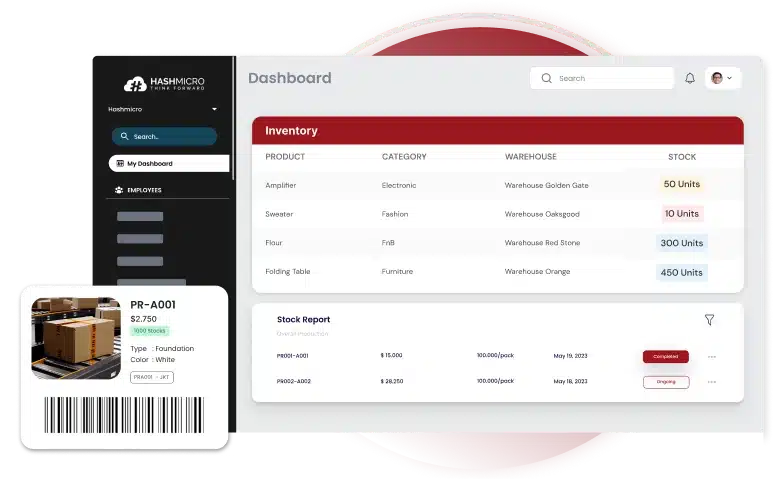In a country with over 7,100 islands, the logistics of moving goods in the Philippines can be both complex and critical. Amidst this setting, a staggering 96% of companies attribute enhanced operational efficiency to the integration of a Warehouse Management System (WMS).
This statistic not only unveils the pivotal role that a WMS meaning in streamlining supply chain processes but also emphasizes its significance in a thriving economy like the Philippines. Whether you’re an established business or a budding enterprise, understanding the fundamentals of a warehouse management system is instrumental in your quest for efficiency and competitiveness.
Through this guide, you will delve into what warehouse system means for your business, exploring how a WMS warehouse operates to maximize productivity.
Key Takeaways
|
Table of Contents

What is a Warehouse Management System (WMS)?
A Warehouse Management System (WMS) is a sophisticated software solution designed to support and enhance the operations of your warehouse or distribution center. Its core functions include inventory control, streamlining the reception of goods, facilitating efficient storage, and ensuring effective picking and packing processes. The primary goal of a WMS system is to provide comprehensive visibility into an organization’s inventory at any place and time, which is crucial for precise forecasting and robust decision-making.
Understanding WMS meaning within the context of modern warehousing technologies is essential. As a central component of a warehousing management system, WMS system integrates seamlessly with other crucial operating systems such as Enterprise Resource Planning (ERP), Customer Relationship Management (CRM), and Transportation Management Systems (TMS). This integration facilitates enhanced performance and synchronization of information across various departments.
By leveraging a WMS, your facility can vastly improve how it handles warehousing management tasks, leading to a more proficient, error-free environment. In addition, the capacity to monitor and control each aspect of the inventory ensures a reliable and continuous supply chain flow, critical for maintaining competitive advantage and customer satisfaction in the Philippines.
Benefits of Warehouse Management System (WMS)
Exploring the myriad advantages of a Warehouse Management System (WMS) can transform how you approach inventory and supply chain management. With precise warehouse inventory management software tailored to enhance supply chain efficiency, reduce operational costs, and improve inventory visibility, a WMS system ensures you are equipped to handle the dynamics of modern logistics.
Reduced Waste and Costs
Inventory optimization through a warehouse system leads directly to cost reduction. By minimizing overstocks, reducing misplaced items, and avoiding unnecessary warehouse movements, your operations become more efficient and less wasteful. Streamlined processes ensure that resources are utilized properly, cutting down on excess expenditure.
Real-time Inventory Visibility
With a WMS software, gaining real-time insights into your inventory levels is effortless. Inventory visibility allows for better decision-making and forecasting, making sure that you are never caught off-guard by supply chain demands. Real-time data tracking helps in maintaining the right stock levels, thereby maximizing business responsiveness and customer satisfaction.
Scalability and Flexibility of Supply Chain Operations
The benefits of WMS cannot be overstated. Whether it’s scaling operations up or down based on market trends or integrating new technologies, a WMS system supports dynamic change. This flexibility is essential for maintaining supply chain efficiency during peak periods or unexpected fluctuations in demand.
Maximize Fulfillment Process
From receiving to shipping, every step in your logistics chain is enhanced with a WMS system. This maximization of the fulfillment process not only speeds up operations but also improves accuracy and customer satisfaction. Efficient handling and storage lead to faster dispatch times, which is crucial in today’s fast-paced market.
RFID and QR Codes Integration
The integration of RFID and QR codes with a WMS software revolutionizes how inventory is managed. These technologies provide quick scanning capabilities, reducing errors and enhancing the speed of inventory checks. With RFID and QR codes, each item’s movement is tracked meticulously, enhancing the accountability and traceability of your stock.

| Feature | Benefits |
| Cost Reduction | Warehouse inventory management software decreases expenses through efficient resource use and waste reduction. |
| Inventory Optimization | Ensures ideal stock levels, preventing overstocking or stockouts. |
| Supply Chain Efficiency | Enhances operations adaptability to market changes. |
| RFID/QR Code Technology | Warehouse inventory management software improves tracking precision and speeds up inventory audits. |
How Does a Warehouse Management System Work?
A Warehouse Management System (WMS) streamlines and optimizes warehouse operations, ensuring efficient inventory management and order fulfillment. Understanding how a WMS works can help businesses enhance productivity, reduce errors, and improve customer satisfaction. Here’s how it operates:
- Inventory tracking and management: A WMS provides real-time visibility into inventory levels, locations, and movements within the warehouse. It tracks products from receiving to shipping, minimizing stock discrepancies and preventing overstocking or stockouts.
- Order processing and fulfillment: The system automates ordering, from picking and packing to shipping. It optimizes picking routes, reduces processing time, and ensures accurate order fulfillment, enhancing overall efficiency and customer satisfaction.
- Receiving and putaway: When new inventory arrives, a WMS records the receipt, verifies product details, and assigns optimal storage locations. This organized putaway process maximizes warehouse space and simplifies future picking.
- Shipping and delivery management: A WMS coordinates shipping by generating shipping labels, scheduling deliveries, and integrating with carriers for real-time tracking. This streamlines logistics, reduces shipping errors, and improves delivery timelines.
- Reporting and analytics: Advanced reporting tools within a WMS provide insights into inventory turnover, order accuracy, and overall operational efficiency. These analytics help management make informed decisions to optimize warehouse performance.
By automating and coordinating these critical tasks, a Warehouse Management System enhances operational efficiency, accuracy, and productivity, ultimately supporting business growth and customer satisfaction.
Type Warehouse Management System
There are several types of Warehouse Management Systems (WMS) designed to meet different business needs. Understanding the various types can help companies choose the most suitable solution for their operations. Here are the main types of WMS:
1. Standalone WMS
This is a dedicated system focused solely on warehouse management functions, such as inventory tracking, picking, packing, and shipping. It is ideal for businesses that need specialized warehouse operations without integrating with other systems.
2. Integrated WMS with ERP
This type of WMS is part of an Enterprise Resource Planning (ERP) system. It integrates warehouse management with other business functions like finance, sales, and procurement, providing a unified view of operations and improving data accuracy.
3. Cloud-Based WMS
Cloud-based WMS solutions are hosted on remote servers and accessed via the internet. They offer flexibility, scalability, and lower upfront costs compared to on-premise systems. They are suitable for businesses looking for remote access and easy software updates.
4. On-Premise WMS
An on-premise WMS is installed locally on a company’s servers. It offers full control and customization but requires higher upfront costs and maintenance. This type is often chosen by large enterprises with complex and unique warehouse requirements.
5. Supply Chain Modules
These are WMS solutions integrated within broader supply chain management systems. They provide end-to-end visibility of inventory flow across the entire supply chain, ensuring efficient logistics and demand planning.
Each type of Warehouse Management System has its advantages and is suitable for different business sizes and operational needs. Selecting the right WMS helps companies optimize inventory management, improve order accuracy, and enhance overall warehouse efficiency.
Features of Warehouse Management System (WMS)
Delving into the advanced functionalities of a Warehousing Management System (WMS), you’ll discover a suite of features designed to enhance your 3D warehouse layout, optimize inventory management, and streamline operations. Whether you’re looking to improve picking solutions, labor optimization, or dock scheduling, the right WMS features can significantly affect your operational efficiency.
3D Warehouse Design
Modern WMS warehouse products support intricate 3D warehouse layouts, helping maximize space utilization and efficiency in material handling. By visualizing and planning your physical space in three dimensions, you can significantly reduce the time spent on moving and managing inventory, which directly translates to cost savings and faster response times.
Inventory Tracking
With robust inventory management capabilities, a WMS warehouse offers various tools like RFID and barcode scanning that update inventory status in real-time. This level of precision is invaluable for maintaining optimal stock levels and addressing demand fluctuations without overstocking or understocking.
Receiving and Storage
Efficient strategies for receiving and storing goods are critical in a high-functioning warehouse. Your WMS software can automate processes to minimize errors and reduce dock scheduling conflicts, ensuring a smooth flow of goods into and out of storage.
Picking and Packing Goods
The WMS software enhances your picking operations through advanced picking solutions such as zone, batch, and wave picking. These methods optimize the picking process, thereby increasing accuracy and reducing turnaround time for fulfilling orders.
Labor Management
Labor optimization is another key feature of a comprehensive WMS software. By tracking individual worker performance and aligning it with warehouse goals, the system not only boosts productivity but also enhances worker satisfaction by identifying and rewarding efficiency.
Yard and Dock Management
Effective yard and dock management ensures that loading and unloading schedules are streamlined. A WMS with integrated dock scheduling features allows for smoother and quicker movement of goods, thereby reducing bottlenecks and speeding up the supply chain.
Reporting and Analytics
Lastly, the WMS provides detailed reports and analytics that offer insights into every aspect of warehouse operations. These analytics help in making data-driven decisions that can further refine your inventory management and overall workflow efficiencies.
| Feature | Benefits | Keywords |
|---|---|---|
| 3D Warehouse Layout | Optimizes space, enhances movement efficiency | 3D warehouse layout, space utilization |
| Inventory Management | Real-time tracking, reduces over/understocking | Inventory management, real-time tracking |
| Picking Solutions | Improves order accuracy, reduces processing time | Picking solutions, order accuracy |
| Labor Optimization | Increases productivity, boosts worker morale | Labor optimization, productivity |
| Dock Scheduling | Reduces bottlenecks, speeds up logistics | Dock scheduling, logistic speed |
Smart Warehousing Technology
To adapt to changing customer buying patterns, sales channels, and expectations and to stay competitive in evolving markets companies must adopt smart warehousing technologies such as artificial intelligence (AI), machine learning, and autonomous robots. Here are some key technologies transforming warehouse operations:
1. Voice Picking Technology
Voice picking, also known as voice-directed warehousing, enables operators to complete tasks hands-free and paperless. Using a voice-picking device, such as a headset or dedicated terminal, workers receive spoken instructions from the Warehouse Management System (WMS) on where and when to pick items.
They can also provide real-time updates to the system using natural language, enhancing communication and productivity.
2. Artificial Intelligence (AI) and Internet of Things (IoT)
AI and IoT transform warehouse management by enabling businesses to respond quickly to changing conditions. IoT sensors gather real-time data from conveyors, mobile devices, RFID tags, and other sources. AI then analyzes this data to provide insights and predictions that guide decision-making.
These technologies help optimize routing, manage labour, dynamically slot inventory, and batch orders more efficiently. By adopting AI and IoT, companies can enhance their warehouse management, increase agility, and stay competitive.
3. Warehouse Automation
Automation technologies are significantly enhancing the efficiency of warehouses and distribution centres. Processes like data collection, barcoding, scanning, order picking, packing, shipping, and inventory tracking can be streamlined through automation.
This increases operational efficiency and scalability and minimizes human errors, such as incorrect shipping details or SKU entries.
The Best WMS in Philippines: HashMicro Cloud-based WMS

If you’re navigating the complex market of warehouse management systems in the Philippines, HashMicro WMS emerges as a leading WMS warehouse in the Philippines, distinguished by its cloud-based functionality. This scalable system is specifically tailored to meet the dynamic requirements of modern supply chains, offering unparalleled benefits in inventory management and overall warehouse operations.
Opting for HashMicro’s Philippines warehouse management system ensures that your warehouse operations are streamlined and cost-effective. Known for its quick setup and easy configurability, it brings forth a robust solution to manage diverse warehousing activities efficiently. The cloud-based WMS software allows for real-time tracking and management of inventory, ensuring that businesses can keep up with market demands and changes swiftly.
| Feature | Benefits |
|---|---|
| Cloud-Based Technology | Provides flexibility and accessibility, reducing needs for in-house IT infrastructure |
| Real-Time Data | Enhances decision-making with up-to-date inventory and operations insights |
| Configurability | Adapts easily to the specific needs of your supply chain and business model |
| Cost Efficiency | Minimizes operational costs through efficient resource management and reduces errors |
Adopting HashMicro’s WMS meaning you are ready to experience a suite of benefits designed to enhance operational efficiency and flexibility. With unlimited user access, businesses can scale their operations without worrying about additional licensing costs. The system is accessible both online and offline, ensuring reliable functionality even in environments with unstable internet connectivity.
Complete integration with other modules streamlines various business processes, creating a cohesive management experience. Additionally, this best warehouse management system provides robust after-sales service and professional assistance, ensuring businesses have the support they need to optimize their operations effectively.
The dependability and efficiency offered by the HashMicro warehouse system make it an indisputable choice for those seeking to elevate their warehouse operations in the Philippines.
Conclusion
In the dynamic market of the Philippines, the strategies you employ for supply chain optimization can make or break your business’s efficiency. The implementation of a robust Warehousing Management System (WMS) is not merely a trend, but a vital necessity for those looking to optimize warehouse operations.
Ultimately, investing in a warehouse system is an investment in the future of your enterprise. Whether you’re taking initial steps towards digital transformation or upgrading existing systems, the goal remains to enhance process efficiency and stay ahead of the competition.
With leading Philippines warehouse inventory management software at your disposal, your business is positioned to meet the ever-growing challenges of supply chain management head-on, ensuring long-term success in a bustling economy.
With solutions like HashMicro’s cloud-based WMS, improved inventory management becomes seamlessly attainable, reinforcing the backbone of your warehousing solutions. Try the free demo now!

FAQ Warehouse Management System (WMS)
-
What is a Warehouse Management System (WMS)?
A Warehouse Management System (WMS) is a software solution designed to optimize warehouse operations. It helps manage inventory, track stock levels, streamline order picking and packing, and improve overall warehouse efficiency. A WMS ensures accurate inventory control and efficient order fulfillment.
-
What are the 4 Types of Warehouse Management Systems?
There are four main types of WMS:
1. Standalone WMS: Focuses solely on warehouse functions such as inventory tracking and order management.
2. Integrated WMS with ERP: Combines warehouse management with other business processes, including finance and procurement, through an Enterprise Resource Planning system.
3. Cloud-Based WMS: Hosted on remote servers and accessed online, offering flexibility and scalability.
4. Supply Chain Modules: Part of a larger supply chain management system, providing end-to-end visibility and logistics optimization. -
What is an Example of Warehouse Management?
An example of warehouse management is the use of barcode scanning for inventory tracking. When products arrive at the warehouse, they are scanned into the system, updating inventory levels in real-time. During order fulfillment, items are picked, packed, and shipped using the WMS, ensuring accurate stock management and timely delivery. This process streamlines operations and reduces errors.




































